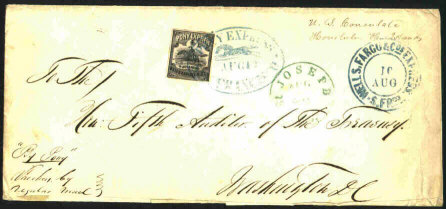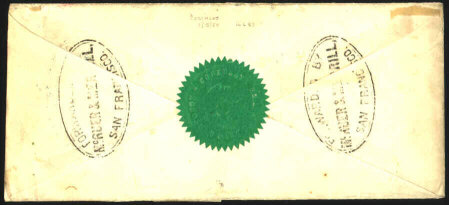|
$4 Pony Express |
A Dead Heat On A $4. Perfecta
One of the two reported $4.00 black Pony Express covers has recently been made available for study. This is truly an item of legend. I had, until a few years ago, believed that an example of the $4.00 black Pony Express stamp did not exist on a genuine cover.
In the book The Pony Express by M.C. Nathan and W.S. Boggs, published by the Collectors Club of New York in 1962, the authors state Regarding the only two known $4 (black) Pony covers examined, photographs of them cannot reconcile their authenticity for several reasons. In discussing Pony Express covers, J. David Baker had earlier mentioned None are reported with the $4 (black) although one or two are believed to exist.
About ten years ago I acquired the George Sloane records. In his records there were detailed notes on the Alfred Caspary Pony Express covers. The only $4.00 black on cover in the Caspary collection was described as being used on a 3c pink entire addressed to San Francisco and bearing a San Jose Wells Fargo oval postmark. Although obviously a fake cover (an impossible usage of a Trans-Continental Pony), Sloane was more cautious saying only that it was curious. Sloane went on to describe Casparys unique $4.00 green Pony Express cover.
On the following page however was a clear black and white photograph of the cover shown below. Sloanes notes attributed it to the H.C. Needham collection and described the back of the cover as well.

$4.00 Black Pony Express Used In 1861. Cover Originated In Hawaii.
This cover
originated in Honolulu, Hawaii and was most likely sent under separate cover to
a forwarding agent in San Francisco. The cover is endorsed U.S. Consulate,
Honolulu, Haw. Islands at top right and bears an embossed, green paper seal
on verso from the Consulate U.S.A., Honolulu, Oahu. The cover probably
left Hawaii on July 17, 1861 on one of two ships that arrived in San Francisco,
California on August 8, 1861. A cover in the 1996 Shreve sale of the Pietch
Hawaii collection, lot #1680, as well as a stampless cover sold in a January 6,
1973 Apfelbaum auction, lot #1222, both show Honolulu July 17, 1861 origin
postmarks and San Francisco August 8, 1861 arrivals. The Pietch cover is a usage
to Germany and bears a further New York City transit of August 31, 1861. The
American consul to Honolulu in July 1861 was John A. Parker.
The outer, enclosing envelope would have been turned over to McRuer & Merrill who were forwarding agents in San Francisco. The back of the cover shows two strikes of their Forwarded By McRuer & Merrill, San Francisco double oval handstamp. This marking is not reported in the American Stampless Cover Catalog and is shown below.

Reverse Of $4.00 Black Pony Express Cover.
The forwarding agents then turned the cover over to Wells, Fargo & Company. A notation at lower left is a directive By Pony, Vouchers By Regular Mail, which I am not so sure the agents obeyed. In any event, the cover atypically received the Wells Fargo, San Francisco double circle Aug 10 datestamp, a $4.00 black Pony Express adhesive was put on to pay the four times rate of $1.00 per one-half ounce, and was tied by the distinctive Pony Express San Francisco August 10 running pony datestamp. There was no United States postage required as it was addressed to the Fifth Auditor of the Treasury who, at the time, was John C. Underwood.
The Pony Express arrived at St. Joseph, Missouri on August 22, 1861 where it entered the regular United States mail for its destination and received a green transit postmark. My best guess of a Washington, D.C. arrival date, from study of other covers of the period, would be around August 25, 1861.
Now, to get to the perfecta part of the story. A second cover, virtually identical, has also come to light again. It also bears a $4.00 black Pony Express adhesive. I understand that it is from the same correspondence and that it also bears Hawaiian Consulate seal, same San Francisco forwarder backstamp, same date Pony Express oval as well as identical St. Joseph, Missouri postmark.
This second cover, from the John Hall collection, may shed some light in understanding the cover shown here. I call your attention to the vouchers by regular mail portion of senders endorsement. I think that it is quite likely that the forwarding agents packaged the vouchers as they had received them, to go by Pony Express in two separate envelopes. This is the only way I can reconcile two different mailings, each weighing between one and one-half ounces and two ounces, on the same date and for such a high cost.
If my previous guess of arrival date is accurate, the sender paid $8. for two letters that arrived in Washington, D.C. about one week earlier than they would have had they been sent, at no postage cost, by regular mail as evidenced by the previously cited Pietch cover.
Neither of these two covers has any auction provenance that I can find. The cover shown here has a pencil note on reverse that it was purchased from Eugene Costales in 1953. The Hall cover may have been purchased from H.P. Atherton. The Sloane notes include an Atherton advertisement, from an undated magazine clipping, which describes A perfect $4.00 Black W-F Pony Stamp used on a large envelope bearing a red seal of The U.S. Consulate at Hawaii on the reverse. Price on application. The Hall cover has a red consular seal on verso.
These two legendary Pony Express covers will make a great day at the races when the dust settles from their eventual public sale.
Richard Frajola (March 23, 2000)


